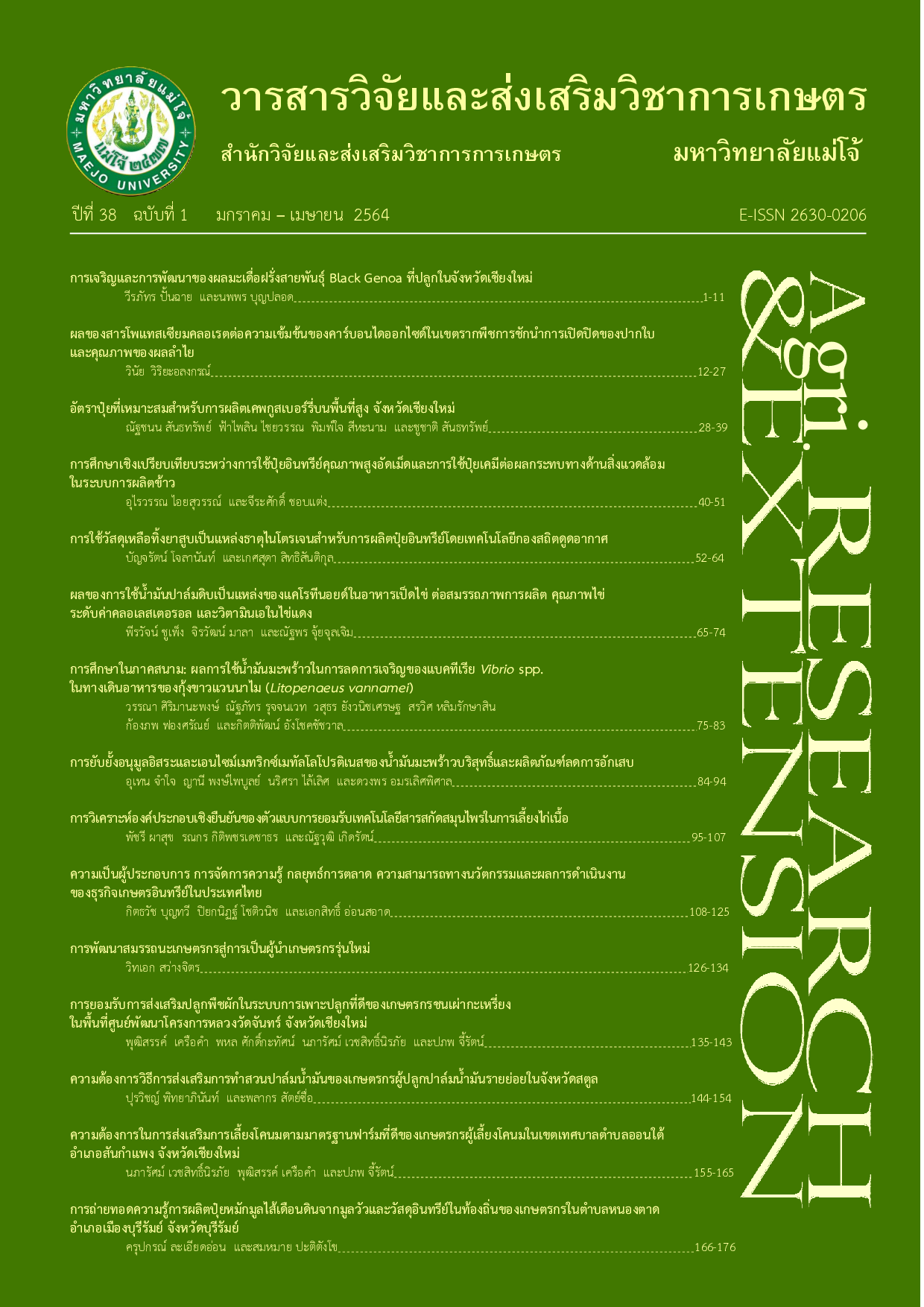การวิเคราะห์องค์ประกอบเชิงยืนยันของตัวแบบการยอมรับเทคโนโลยีสารสกัดสมุนไพร ในการเลี้ยงไก่เนื้อ
คำสำคัญ:
การยอมรับเทคโนโลยี, สารสกัดสมุนไพร, ไก่เนื้อ, การวิเคราะห์องค์ประกอบเชิงยืนยันบทคัดย่อ
การวิจัยครั้งนี้มีวัตถุประสงค์เพื่อศึกษาการยอมรับเทคโนโลยีสารสกัดสมุนไพรเพื่อการเลี้ยงไก่เนื้อด้วยการประยุกต์แนวคิดการยอมรับเทคโนโลยี (TAM) ร่วมกับการวิเคราะห์ตัวชี้วัดด้วยตัวแบบวิเคราะห์องค์ประกอบเชิงยืนยัน โดยเก็บรวบรวมข้อมูลจากฟาร์มไก่ทั้งขนาดเล็ก กลาง ใหญ่ ในจังหวัดลพบุรี สระบุรี และกาญจนบุรี จำนวน 100 ตัวอย่าง ด้วยการสุ่มแบบตามสะดวก ผลการศึกษาพบว่า มิติการรับรู้ประโยชน์ของเทคโนโลยี และมิติของการรับรู้ความง่ายในการใช้งานเทคโนโลยี ส่งผลในเชิงบวกต่อการยอมรับเทคโนโลยีอย่างมีนัยสำคัญทางสถิติ ตัวชี้วัดที่มีอิทธิพลสูงสุดในมิติการรับรู้ประโยชน์ของเทคโนโลยี คือ การที่สารสกัดสมุนไพรให้ประสิทธิผลเทียบเท่ายาปฏิชีวนะ และการที่สารสกัดสมุนไพรมีต้นทุนที่ถูกกว่ายาปฏิชีวนะเป็นตัวชี้วัดที่มีอิทธิพลสูงสุดในมิติของการรับรู้ความง่ายในการใช้งานเทคโนโลยี จากผลการวิจัยผู้วิจัยขอเสนอแนะเชิงนโยบายแก่หน่วยงานที่เกี่ยวข้องว่า ควรให้ความสำคัญต่อการส่งเสริมองค์ความรู้ทางด้านสารสกัดสมุนไพรและการนำไปใช้อย่างถูกต้องในอุตสาหกรรมการผลิตสัตว์ทุกแขนง ทั้งนี้เพื่อลดการตกค้างของสารเคมีและสร้างมาตรฐานการส่งออกที่ดีในอนาคต
เอกสารอ้างอิง
Adesina, A.A. and M.M. Zinnah. 1993. Technology characteristics, farmers' perceptions and adoption decisions: a tobit model application in Sierra Leone. Agricultural Economics 9(4): 297-311.
Adesina, A.A., and J. Baidu-Forson. 1995. Farmers' perceptions and adoption of new agricultural technology: evidence from analysis in Burkina Faso and Guinea, West Africa. Agricultural Economics 13(1): 1-9.
Ajzen, I. 1991. The theory of planned behavior. Organizational Behavior and Human Decision Processes 50(2): 179-211.
Aubert, B.A., A. Schroeder and J. Grimaudo. 2012. IT as enabler of sustainable farming: an empirical analysis of farmers' adoption decision of precision agriculture technology. Decision Support Systems 54(1): 510-520.
Bonabana-Wabbi, J. 2002. Assessing Factors Affecting Adoption of Agricultural Technologies: The Case of Integrated Pest Management (IPM) in Kumi District, Eastern Uganda. Doctoral Dissertation. Virginia Tech. 13 p.
Davis, F.D. 1989. Perceived usefulness, perceived ease of use, and user acceptance of information technology. MIS Quarterly 13(3): 319-340.
Davis, F.D., R.P. Bagozzi and P.R. Warshaw. 1989. User acceptance of computer technology: a comparison of two theoretical models. Management Science 35(8): 982-1003.
D'souza, G., D. Cyphers and T. Phipps. 1993. Factors affecting the adoption of sustainable agricultural practices. Agricultural and Resource Economics Review 22(2): 159-165.
Ghimire, R., H. Wen-chi and R.B. Shrestha. 2015. Factors affecting adoption of improved rice varieties among rural farm households in Central Nepal. Rice Science 22(1): 35-43.
Hu, P.J., P.Y.K. Chau, O.R.L. Sheng and K.Y. Tam. 1999. Examining the technology acceptance model using physician acceptance of telemedicine Technology. Journal of Management Information Systems 16(2): 91-112.
Jokar, N.K., S.A. Noorhosseini, M.S. Allahyari and C.A. Damalas. 2017. Consumers' acceptance of medicinal herbs: an application of the technology acceptance model (TAM). Journal of Ethnopharmacology 207: 203-210.
Mignouna, D., V. Manyong, J. Rusike, K. Mutabazi and E. Senkondo. 2011. Determinants of adopting imazapyr-resistant maize technologies and its impact on household income in Western Kenya. AgBioForum 14(3): 158-163.
Ministry of Commerce. 2019. Export value in agricultural section. [Online]. Available http://www.ops3.moc.go.th/export/recode_export_rank/report.asp (2 February 2020).
Mottaleb, K.A. 2018. Perception and adoption of a new agricultural technology: evidence from a developing country. Technology in Society 55: 126-135.
Mwangi, M. and S. Kariuki. 2015. Factors determining adoption of new agricultural technology by smallholder farmers in developing countries. Journal of Economics and Sustainable Development 6(5): 208-216.
Park, N., R. Roman, S. Lee and J.E. Chung. 2009. User acceptance of a digital library system in developing countries: an application of the technology acceptance model. International Journal of Information Management 29(3): 196-209.
Roger, E.M. 1962. Diffusion of Innovations. New.York: Free Press. 576 p.
Thajel, F. and A.H. Ulaiwi. 2017. Effect of AROMAX® on performance, local and humoral immunity against vaccination of Newcastal disease in the low management level in broiler chicken. J. Entomol. Zool. Stud. 5(5): 1986-1990.
Tu, V.H., N.D. Can, Y. Takahashi, S.W. Kopp and M. Yabe. 2018. Modelling the factors affecting the adoption of eco-friendly rice production in the Vietnamese Mekong Delta. Cogent Food & Agriculture 4(1): 1432538.
Venkatesh, V., C. Speier and M.G. Morris. 2002. User acceptance enablers in individual decision making about technology: toward an integrated model. Decision Sciences33(2): 297-316.
Venkatesh, V., M.G Morris, G.B. Davis, and F.D. Davis. 2003. User Acceptance of Information Technology: toward a unified view. MIS Quarterly 27(3): 425-478.
Zheng, S., Z. Wang and J. Wachenheim Cheryl. 2019. Technology adoption among farmers in Jilin province, China: the case of aerial pesticide application. China Agricultural Economic Review 11(1): 206-216.
ดาวน์โหลด
เผยแพร่แล้ว
รูปแบบการอ้างอิง
ฉบับ
ประเภทบทความ
สัญญาอนุญาต
บทความนี้ได้รับการเผยแพร่ภายใต้สัญญาอนุญาต Creative Commons Attribution-NonCommercial-NoDerivatives 4.0 International (CC BY-NC-ND 4.0) ซึ่งอนุญาตให้ผู้อื่นสามารถแชร์บทความได้โดยให้เครดิตผู้เขียนและห้ามนำไปใช้เพื่อการค้าหรือดัดแปลง หากต้องการใช้งานซ้ำในลักษณะอื่น ๆ หรือการเผยแพร่ซ้ำ จำเป็นต้องได้รับอนุญาตจากวารสาร





